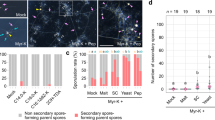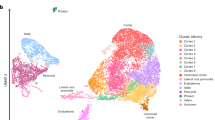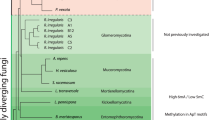Abstract
Arbuscular mycorrhizal fungi (AMF) occur in the rhizosphere and in plant tissues as obligate symbionts, having key roles in plant evolution and nutrition. AMF possess endobacteria, and genome sequencing of the endobacterium Candidatus Glomeribacter gigasporarum revealed a reduced genome and a dependence on the fungal host. To understand the effect of bacteria on fungal fitness, we used next-generation sequencing to analyse the transcriptional profile of Gigaspora margarita in the presence and in the absence of its endobacterium. Genomic data on AMF are limited; therefore, we first generated a gene catalogue for G. margarita. Transcriptome analysis revealed that the endobacterium has a stronger effect on the pre-symbiotic phase of the fungus. Coupling transcriptomics with cell biology and physiological approaches, we demonstrate that the bacterium increases the fungal sporulation success, raises the fungal bioenergetic capacity, increasing ATP production, and eliciting mechanisms to detoxify reactive oxygen species. By using TAT peptide to translocate the bioluminescent calcium reporter aequorin, we demonstrated that the line with endobacteria had a lower basal intracellular calcium concentration than the cured line. Lastly, the bacteria seem to enhance the fungal responsiveness to strigolactones, the plant molecules that AMF perceive as branching factors. Although the endobacterium exacts a nutritional cost on the AMF, endobacterial symbiosis improves the fungal ecological fitness by priming mitochondrial metabolic pathways and giving the AMF more tools to face environmental stresses. Thus, we hypothesise that, as described for the human microbiota, endobacteria may increase AMF innate immunity.
Similar content being viewed by others
Log in or create a free account to read this content
Gain free access to this article, as well as selected content from this journal and more on nature.com
or
Accession codes
References
Abbà S, Khouja HR, Martino E, Archer DB, Perotto S . (2009). SOD1-targeted gene disruption in the ericoid mycorrhizal fungus Oidiodendron maius reduces conidiation and the capacity for mycorrhization. Mol Plant Microbe Interact 22: 1412–1421.
Anders S, Huber W . (2010). Differential expression analysis for sequence count data. Genome Biol 11: R106.
Bencina M, Legisa M, Read ND . (2005). Cross-talk between cAMP and calcium signalling in Aspergillus niger. Mol Microbiol 56: 268–281.
Besserer A, Puech-Pages V, Kiefer P, Gomez-Roldan V, Jauneau A, Roy S et al. (2006). Strigolactones stimulate arbuscular mycorrhizal fungi by activating mitochondria. PLoS Biol 4: e226.
Bianciotto V, Bandi C, Minerdi D, Sironi M, Tichy HV, Bonfante P . (1996). An obligately endosymbiotic mycorrhizal fungus itself harbors obligately intracellular bacteria. App Environ Microbiol 62: 3005–3010.
Bianciotto V, Lumini E, Bonfante P, Vandamme P . (2003). 'Candidatus glomeribacter gigasporarum' gen. nov., sp. nov., an endosymbiont of arbuscular mycorrhizal fungi. Int J Syst Evol Microbiol 53: 121–124.
Bohm J, Hoff B, O'Gorman CM, Wolfers S, Klix V, Binger D et al. (2013). Sexual reproduction and mating-type-mediated strain development in the penicillin-producing fungus Penicillium chrysogenum. Proc Natl Acad Sci USA 110: 1476–1481.
Bonfante P, Anca IA . (2009). Plants, mycorrhizal fungi, and bacteria: a network of interactions. Annu Rev Microbiol 63: 363–383.
Bonfante P, Balestrini R, Mendgen K . (1994). Storage and secretion processes in the spore of Gigaspora-margarita Becker and Hall as revealed by high-pressure freezing and freeze-substitution. New Phytol 128: 93–101.
Bonfante P, Genre A . (2010). Mechanisms underlying beneficial plant-fungus interactions in mycorrhizal symbiosis. Nat Comm 1: 48.
Case RM, Eisner D, Gurney A, Jones O, Muallem S, Verkhratsky A . (2007). Evolution of calcium homeostasis: From birth of the first cell to an omnipresent signalling system. Cell Calcium 42: 345–350.
Chu HT, Mazmanian SK . (2013). Innate immune recognition of the microbiota promotes host-microbial symbiosis. Nat Immunol 14: 668–675.
Desirò A, Salvioli A, Ngonkeu EL, Mondo SJ, Epis S, Faccio A et al. (2014). Detection of a novel intracellular microbiome hosted in arbuscular mycorrhizal fungi. ISME J 8: 257–270.
Genre A, Chabaud M, Balzergue C, Puech-Pages V, Novero M, Rey T et al. (2013). Short-chain chitin oligomers from arbuscular mycorrhizal fungi trigger nuclear Ca2+ spiking in Medicago truncatula roots and their production is enhanced by strigolactone. New Phytol 198: 179–189.
Gerdemann JW .and Nicolson TH . (1963). Spores of mycorrhizal Endogone extracted from soil by wet sieving and decanting. Trans Brit Mycol Soc 46: 235–244.
Ghignone S, Salvioli A, Anca I, Lumini E, Ortu G, Petiti L et al. (2012). The genome of the obligate endobacterium of an AM fungus reveals an interphylum network of nutritional interactions. ISME J 6: 136–145.
Gilroy S, Suzuki N, Miller G, Choi WG, Toyota M, Devireddy AR et al. (2014). A tidal wave of signals: calcium and ROS at the forefront of rapid systemic signaling. Trends Plant Sci 19: 623–630.
Grabherr MG, Haas BJ, Yassour M, Levin JZ, Thompson DA, Amit I et al. (2011). Full-length transcriptome assembly from RNA-Seq data without a reference genome. Nat Biotechnol 29: 644–U130.
Hempel S, Renker C, Buscot F . (2007). Differences in the species composition of arbuscular mycorrhizal fungi in spore, root and soil communities in a grassland ecosystem. Environ Microbiol 9: 1930–1938.
Lanfranco L, Novero M, Bonfante P . (2005). The mycorrhizal fungus Gigaspora margarita possesses a CuZn superoxide dismutase that is up-regulated during symbiosis with legume hosts. Plant Physiol 137: 1319–1330.
Lin K, Limpens E, Zhang ZH, Ivanov S, Saunders DGO, Mu DS et al. (2014). Single nucleus genome sequencing reveals high similarity among nuclei of an endomycorrhizal fungus. PLoS Genet 10: e1004078.
Liu Y, Gianinazzi-Pearson V, Arnould C, Wipf D, Zhao B, Van Tuinen D . (2013). Fungal genes related to calcium homeostasis and signalling are upregulated in symbiotic arbuscular mycorrhiza interactions. Fungal Biol 117: 22–31.
Love M, Anders S, Hubert W . (2013), Differential analysis of count data - the DESeq2 package http://www.bioconductor.org/packages/2.13/bioc/vignettes/deseq2/inst/doc/deseq2.pdf.
Lumini E, Bianciotto V, Jargeat P, Novero M, Salvioli A, Faccio A et al. (2007). Presymbiotic growth and sporal morphology are affected in the arbuscular mycorrhizal fungus Gigaspora margarita cured of its endobacteria. Cell Microbiol 9: 1716–1729.
Luo WJ, Brouwer C . (2013). Pathview: an R/Bioconductor package for pathway-based data integration and visualization. Bioinformatics 29: 1830–1831.
Maldonado-Mendoza IE, Dewbre GR, Harrison MJ . (2001). A phosphate transporter gene from the extra-radical mycelium of an arbuscular mycorrhizal fungus Glomus intraradices is regulated in response to phosphate in the environment. Mol Plant Microbe Interact 14: 1140–1148.
Martin F, Kohler A, Murat C, Balestrini R, Coutinho PM, Jaillon O et al. (2010). Perigord black truffle genome uncovers evolutionary origins and mechanisms of symbiosis. Nature 464: 1033–1038.
Martin F, Selosse MA . (2008). The Laccaria genome: a symbiont blueprint decoded. New Phytol 180: 296–310.
Mondo SJ, Toomer KH, Morton JB, Lekberg Y, Pawlowska TE . (2012). Evolutionary stability in a 400-million-year-old heritable facultative mutualism. Evolution 66: 2564–2576.
Moreira PI, Carvalho C, Zhu X, Smith MA, Perry G . (2010). Mitochondrial dysfunction is a trigger of Alzheimer's disease pathophysiology. Biochim Biophys Acta 1802: 2–10.
Moscatiello R, Sello S, Novero M, Negro A, Bonfante P, Navazio L . (2014). The intracellular delivery of TAT-aequorin reveals calcium-mediated sensing of environmental and symbiotic signals by the arbuscular mycorrhizal fungus Gigaspora margarita. New Phytol 203: 1012–1020.
Moscatiello R, Squartini A, Mariani P, Navazio L . (2010). Flavonoid-induced calcium signalling in Rhizobium leguminosarum bv. viciae. New Phytol 188: 814–823.
Mu DS, Li CY, Zhang XC, Li XB, Shi L, Ren A et al. (2014). Functions of the nicotinamide adenine dinucleotide phosphate oxidase family in Ganoderma lucidum: an essential role in ganodermic acid biosynthesis regulation, hyphal branching, fruiting body development, and oxidative-stress resistance. Environ Microbiol 16: 1709–1728.
Novero M, Faccio A, Genre A, Stougaard J, Webb KJ, Mulder L et al. (2002). Dual requirement of the LjSym4 gene for mycorrhizal development in epidermal and cortical cells of Lotus japonicus roots. New Phytol 154: 741–749.
Oldroyd GED . (2013). Speak, friend, and enter: signalling systems that promote beneficial symbiotic associations in plants. Nat Rev Microbiol 11: 252–263.
Pelin A, Pombert JF, Salvioli A, Bonen L, Bonfante P, Corradi N . (2012). The mitochondrial genome of the arbuscular mycorrhizal fungus Gigaspora margarita reveals two unsuspected trans-splicing events of group I introns. New Phytol 194: 836–845.
Popova Y, Thayumanavan P, Lonati E, Agrochao M, Thevelein JM . (2010). Transport and signaling through the phosphate-binding site of the yeast Pho84 phosphate transceptor. Proc Natl Acad Sci USA 107: 2890–2895.
Ryder LS, Dagdas YF, Mentlak TA, Kershaw MJ, Thornton CR, Schuster M et al. (2013). NADPH oxidases regulate septin-mediated cytoskeletal remodeling during plant infection by the rice blast fungus. Proc Natl Acad Sci USA 110: 3179–3184.
Salvioli A, Chiapello M, Fontaine J, Hadj-Sahraoui AL, Grandmougin-Ferjani A, Lanfranco L et al. (2010). Endobacteria affect the metabolic profile of their host Gigaspora margarita, an arbuscular mycorrhizal fungus. Environ Microbiol 12: 2083–2095.
Salvioli A, Lumini E, Anca IA, Bianciotto V, Bonfante P . (2008). Simultaneous detection and quantification of the unculturable microbe Candidatus Glomeribacter gigasporarum inside its fungal host Gigaspora margarita. New Phytol 180: 248–257.
Salvioli A, Zouari I, Chalot M, Bonfante P . (2012). The arbuscular mycorrhizal status has an impact on the transcriptome profile and amino acid composition of tomato fruit. BMC Plant Biol 27: 12–44.
Tisserant E, Malbreil M, Kuo A, Kohler A, Symeonidi A, Balestrini R et al. (2013). Genome of an arbuscular mycorrhizal fungus provides insight into the oldest plant symbiosis. Proc Natl Acad Sci USA 110: 20117–20122.
Varela-Cervero S, Vasar M, Davison J, Barea JM, Opik M, Azcon-Aguilar C . (e-pub ahead of print 11 February 2015). The composition of arbuscular mycorrhizal fungal communities differs among the roots, spores and extraradical mycelia associated with five Mediterranean plant species. Environ Microbiol.
Xu Z, Hao BL . (2009). CVTree update: a newly designed phylogenetic study platform using composition vectors and whole genomes. Nucleic Acids Res 37: W174–W178.
Young MD, Wakefield MJ, Smyth GK, Oshlack A . (2010). Gene ontology analysis for RNA-seq: accounting for selection bias. Genome Biol 11: R14.
Zhivotovsky B, Orrenius S . (2011). Calcium and cell death mechanisms: A perspective from the cell death community. Cell Calcium 50: 211–221.
Acknowledgements
This paper is dedicated to the memory of Professor Aldo Fasolo, his inexhaustible scientific curiosity, support and inspiration. We wish to thank: Luisa Lanfranco (University of Torino) and Nicholas Corradi (University of Vancouver) for their contributions in the first phases of the project; Andrea Genre (University of Torino) for drawing Figure 9; Mauro degli Esposti (IIT-Genova) for the discussion on bionergetics and for having suggested us to use the Mytotracker staining; Matteo Chialva (University of Torino) for the Pi measurements in plants; Antonella Faccio (IPSP-CNR) for her assistance in electron microscopy; Paola Giannini, Marco Malavasi (University of Piemonte Orientale), Giancarlo Birello (IRCrES-CNR, IT Office) and Raffaele Calogero (University of Torino) for their bioinformatics support; Maria Teresa Della Beffa and Sara Torrielli (University of Torino) for the taking care of the spore production, and Jennifer Mach for the critical reading. Research was funded by the Ateneo Project (ex 60%) to PB. AS fellowship was granted by Piedmont Region and University of Torino.
Author information
Authors and Affiliations
Corresponding author
Ethics declarations
Competing interests
The authors declare no conflict of interest.
Additional information
Supplementary Information accompanies this paper on The ISME Journal website
Supplementary information
Rights and permissions
About this article
Cite this article
Salvioli, A., Ghignone, S., Novero, M. et al. Symbiosis with an endobacterium increases the fitness of a mycorrhizal fungus, raising its bioenergetic potential. ISME J 10, 130–144 (2016). https://doi.org/10.1038/ismej.2015.91
Received:
Revised:
Accepted:
Published:
Issue date:
DOI: https://doi.org/10.1038/ismej.2015.91
This article is cited by
-
Hyphosphere microorganisms facilitate hyphal spreading and root colonization of plant symbiotic fungus in ammonium-enriched soil
The ISME Journal (2023)
-
Insight into the Physiological and Molecular Crosstalk During Bacterial-Fungal Interactions
Current Clinical Microbiology Reports (2023)
-
Arbuscular mycorrhizal fungi and Bacillus promote Flaveria bidentis invasion success by inhibiting the growth of native species under different soil nutrient levels
Plant and Soil (2023)
-
On Holobionts, Holospecies, and Holoniches: the Role of Microbial Symbioses in Ecology and Evolution
Microbial Ecology (2023)
-
Exploring the secrets of hyphosphere of arbuscular mycorrhizal fungi: processes and ecological functions
Plant and Soil (2022)



